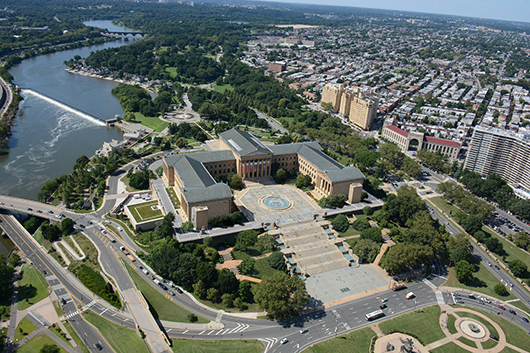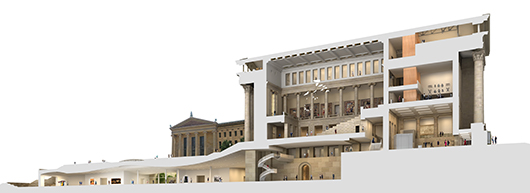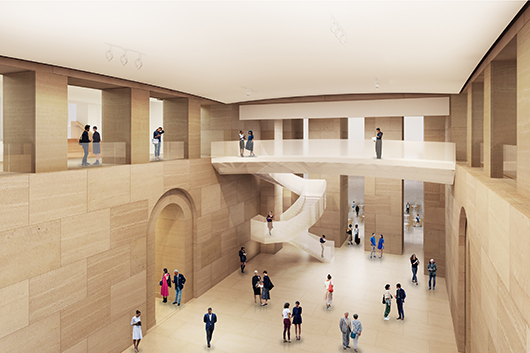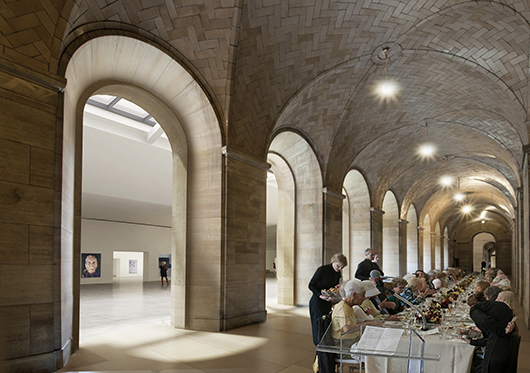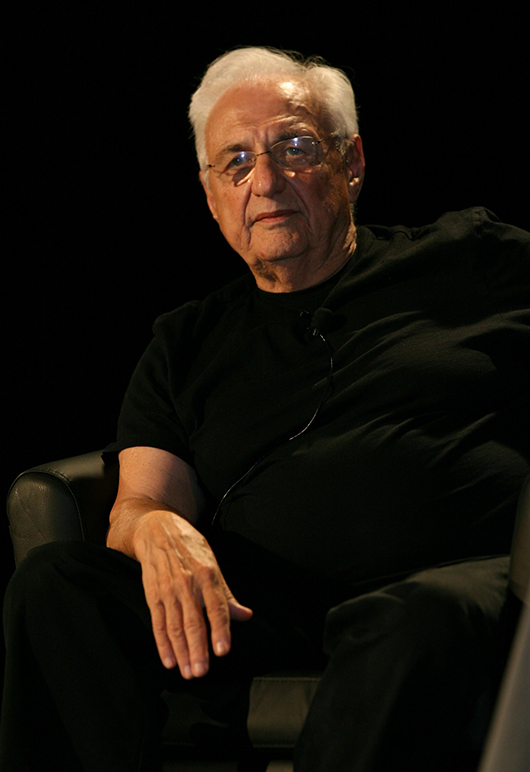
The plan also reorganizes and expands the building, adding more than 169,000 square feet of space. Included in this exhibition, which will remain on view in the Dorrance Galleries until Sept. 1, will be large-scale models, site plans, sections and renderings. The project will ultimately transform the interior of one of the city’s most iconic buildings, enabling the museum to display much more of its world-renowned collection.
“Making a Classic Modern” will introduce visitors to the various ways in which Frank Gehry and his creative team have addressed the challenges and opportunities of updating this historic facility. The building is in need of substantial renovation, reorganization and expansion to meet current and future needs.
The master plan encompasses the full breadth of the museum, from the east entrance with its iconic “Rocky steps” facing Center City to the west entrance overlooking the Schuylkill River. Although he is best known for the expressive, sculptural forms of buildings such as the Guggenheim Museum in Bilbao, Spain, and Walt Disney Concert Hall in Los Angeles, Gehry has taken an approach to this project that is dramatically different and virtually unique.
Gehry’s design focuses on the transformation of the interior of the museum through the renovation of beloved spaces such as the Great Stair Hall and major improvements to how visitors will enter and move through the building. The design also calls for the creation of a significant amount of new space for expanded educational activities and the display of the museum’s extensive holdings of American, Asian and modern and contemporary art in new galleries created both within the existing building and underneath the East Terrace.
On view will be carefully detailed large-scale models, architectural drawings, photographs and videos that will enable visitors to explore the history of the building. The exhibition will also include works of art, many of which were acquired during the last decade, to demonstrate how this project can make it possible for the museum to display much more of its collection. The new galleries are among the most prominent features of Gehry’s plan.
“We began by studying the character of this wonderful building—its DNA, so to speak. It is rare to have the bones of the existing building show you the way to expand it,” said Gehry. “From there, we used the significant assets that the original architects gave us to create a strong entry sequence and circulation pattern that connects the new galleries to the existing building in a way that makes the new galleries seem like they have always been there. My goal is to make the building feel like one coherent design statement.”
Given the prominence of the museum’s main building as a landmark, minimal changes have been proposed for the exterior by Gehry Partners and OLIN, the noted Philadelphia firm specializing in landscape architecture, planning and urban design. These changes include the redesign of the plaza in front of the west entrance and the landscaping of a substantial portion of the area now used for parking on this side of the building; the integration of skylights and sunken gardens into the East Terrace to bring natural light into the new galleries that have been proposed; and the addition on the northeast and southeast corners of the building of stair enclosures that will be simple in form and clad in the same sandstone used on the exterior in order to be as unobtrusive as possible.
By contrast, many significant changes have been proposed for the interior, yielding an increase of 124,000 square feet of public space, including 78,000 square feet of gallery space throughout the building. Other changes address access and circulation through the varying “ground” levels of the facility. At present, visitors enter the museum on the first floor through the east entrance and the Great Stair Hall or on the slightly lower floor through the west entrance and Lenfest Hall. The Gehry design will open new spaces to explore, such as the Forum and new galleries under the East Terrace.
Among the interior changes are:
– The renovation of the two principal public entrance spaces in the Museum: Lenfest Hall and the Great Stair Hall.
– The creation of a new public space, or Forum, immediately below the Great Stair Hall in the center of the U-shaped museum building. The Forum will dramatically improve circulation on this floor and open up the east-west axis at the center of the building, enabling visitors to reach the new galleries and adjacent public spaces that Gehry Partners have proposed be built below the East Terrace.
– The relocation of a variety of back-office functions to add nearly 23,000 square feet of new gallery space within the existing building; the creation of a new 10,000-square-foot Education Center; and the development of new visitor amenities, including a restaurant, café, and spaces for the Museum Store.
– The creation of 55,000 square feet of new space for the presentation of special exhibitions and works from the collection in galleries underneath the East Terrace. Ranging in height from 24 to 28 feet, with a vaulted ceiling supported on slender columns, these new galleries will be among the largest and most spacious in the entire Museum. Open in plan and filled with natural light, they will provide an ideal setting for the display of modern and contemporary art.
– The reopening of a public entrance on the north side of the museum. Closed to the public since the 1970s, this monumental arched entrance adjacent to Kelly Drive will be renovated to provide access to a grand vaulted corridor – part of the original design of the building – that runs 640 feet from the north to the south side of the building. This walkway will provide access to the new galleries through a long, vaulted arcade and will intersect with the new Forum directly below the Great Stair Hall, thus providing access to the entire building for visitors entering on this level.
– A new 299-seat auditorium equipped for lectures, performances, and public events, to be located underneath the northwest terrace of the main building and directly accessible from the new public entrance facing Kelly Drive.
– The adaptation of the center portion of the top floor of the U-shaped museum building to create meeting and event spaces, and the replacement of the brick in the pediments with glass to provide dramatic views of the city and Fairmount Park.
ADDITIONAL IMAGES OF NOTE
